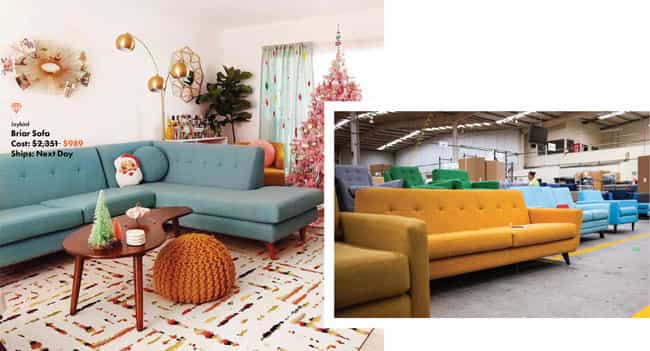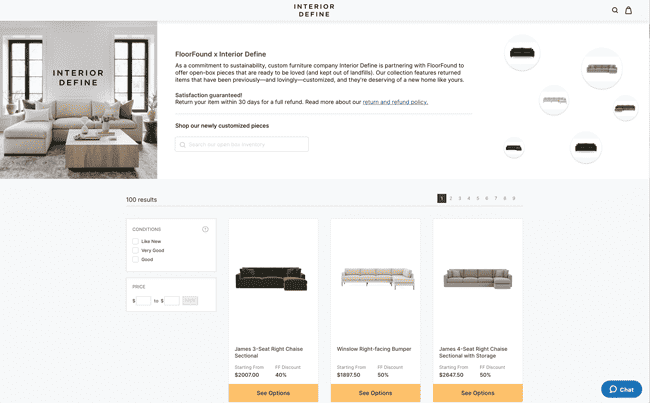Interview with Chris Richter
Furniture
recommerce can be a next big thing for furniture retailers who want to
tell sustainable stories, acquire new customers and add income from
returned items.
Although eBay claims on its website that it “pioneered recommerce, the
buying and selling of pre‑owned goods,” the practice is almost as old as
commerce itself. The used car and antiques market, garage sales and
thrift stores all come to mind. And although it’s not a new idea, it has
become an interesting and timely trend. A recent report out of
Wharton/First Insight found that 83% of consumers across all generations
will continue to purchase secondhand products compared to only 17% in
2019. Projections are that U.S. resale is set to grow more than 150
percent to top $330 billion by 2030.
Furniture World spoke about recommerce with Chris Richter, who along
with Ryan Matthews, founded FloorFound, a company that provides a way
for furniture retailers to resell returned or used furniture to
consumers.
Building Trust, Making it Easy
Before launching the company, Richter, who has a background in
e-commerce and supply chain logistics, was paying attention to new
online resale marketplaces for furniture, fashion and home furnishings
that matched buyers and sellers. “These,” he said, “included Poshmark
(poshmark.com) and The RealReal (therealreal.com) in the luxury resale
space, as well as Chairish (chairish.com) and 1stdibs (1stdibs.com)
reselling furniture and home décor.
“This group of fast-growing companies,” he continued, “were really
crushing it by catering to consumers looking for unique items and cared
deeply about sustainability.” They offered trusted ways to resell items,
including bulky furniture, that might have previously been offered for
sale on eBay or Craigslist where users were responsible for all the
details of making the sale, packaging, arranging for delivery and
insurance.
“Visiting furniture stores in my home city, Austin, Texas,” he
continued, “I noticed that floor models were being marked down in a
store-specific way without any rhyme or reason. So, my question was,
might there be a way for me to see all the floor model returns from a
retailer like Restoration Hardware without visiting their stores all
over the country?”
 Image (at left) was excerpted from the “The e-commerce Opportunity
for Oversized Products” study found at
www.floorfound.com.
Image (at left) was excerpted from the “The e-commerce Opportunity
for Oversized Products” study found at
www.floorfound.com.
One of their warehouse and refurbishment centers is pictured
below.
Problems with Returns
“At the same time,” he added, “click and brick furniture retailers were
getting tens or even hundreds of thousands of returns per year. Bringing
back and reselling all these items in clearance centers was problematic,
especially when reverse logistics were impractical. Ryan and I realized
that this problem could be solved with a solid recommerce strategy for
returns that generates revenue, facilitates new customer acquisition and
achieves other business goals.”
How FloorFound Works
Richter explained the process. “Let’s say that a customer who lives
somewhere in California buys a sofa from an e-commerce website, like
Crate&Barrel.
“Upon receiving the item, this customer decides to return it and calls
the retailer’s customer care line.
“It turns out that the nearest distribution center is too far away from
where the item can be returned to, so the retailer first offers the
customer a discount to keep the item. If the customer refuses, they may
let them keep it for free or offer to haul it off to a landfill rather
than repairing and restocking it.
“As an alternative, FloorFound developed a return logistics model that
takes the request, arranges for pick up via LTL, and brings the item
back to one of 42 warehouse locations or to be retrieved by a
third-party logistics provider and taken to one of their last-mile hubs.
“Software is then used to run an inspection process to determine what,
if anything, is wrong with the item. It could be missing a leg, or have
a scratch, ding, dent or a tear. Items are then priced for resale and
listed online.
“For us, there are a few different ways we can sell returned items. Our
client, Living Spaces, for example, lists returns that aren’t economical
to bring back for in-store resale on a branded Living Spaces site hosted
and managed by FloorFound. One benefit of reselling on a branded channel
is new customer acquisition of people who prefer recommerce, not just
because they get a good deal, but also because they believe in the
virtue of keeping furniture out of landfills.
“Ninety-five percent of the items we get back are perfectly good and
perfectly resellable?. Presently we do light refurbishment but plan to
scale up repair and refurb over the next couple of years.”
Why Don’t More Furniture Retailers Do Recommerce?
Furniture World asked Richter why more furniture retailers haven’t
jumped on the recommerce model. He replied, “Sustainability and
regenerative commerce are trending topics that are not going to fade
away. Eventually, just about every furniture retailer will have to get
onboard in some form or another.
It makes sense for retailers to start to think about the full
lifetime value potential of a piece of furniture that starts with an initial sale and continues through subsequent sales
in the second quality and used marketplace.”
The largest percentage of retail brands that have adopted recommerce do
at least 15 to 30 percent of their volume via e-commerce. They are
committed to sustainable practices and understand that their customers
will respond positively to this program.
“There are lots of other retailers, however, who are afraid of how
branded resale efforts might affect the perception of their brand or
concerned that the practice might cannibalize their sales of new
furniture.
“The experience of Floyd (West Elm, Pottery Barn, etc.) tells a
different story. Floyd found that roughly 25 percent of first-time
shoppers that bought their recommerce offerings came back and purchased
a new item within 30 days. These were primarily customers who hadn’t
purchased from their brand before. Recommerce turned out to be an
excellent opportunity for them to sell to a new kind of customer and
build brand loyalty.”
IKEA Jumps In
IKEA recently announced the extension of the pilot Buy Back & Resell
service would become permanent. That program permits “IKEA Family
Members” to sell their gently used IKEA furniture back to IKEA in
exchange for store credit. Items will be sold in “As Is” areas of IKEA
stores. Although FloorFound is designed to handle returns, it’s easy to
imagine a similar model where higher-end used furniture could be
repurchased by a retailer or used as a trade-in on previously purchased
goods with certain conditions.
“IKEA has become the poster child for this idea,” Richter noted. “A
model like this could be similar to what car dealerships do when they
reach out to customers to buy back cars for resale. Taking back a used
car creates a recommerce opportunity and helps to sell a previous
customer a new car.”
Standing Behind What We Sell
Furniture World asked Richter if furniture recommerce might breathe new
life into the old sales adage that if you buy a quality piece of
furniture it will last a lifetime.
“There is value in the idea that retailers stand behind what they sell,”
Richter agreed. “It makes sense,” he observed, “for them to think about
the full lifetime value potential of a piece of furniture, that starts
with an initial sale and continues through subsequent sales in the
second quality and used marketplace. It’s the start of a circular
economy proposition that increasingly makes sense.
Highlights of 2021 FloorFound Survey
-
Top 3 Present Resale Items: The top three resale
items purchased by Americans last year were: clothing (44%),
furniture (28%) and footwear (22%).
-
Millennial & GenZ Shoppers: Six in 10 (59%)
sometimes or often purchase furniture on Facebook Marketplace—and
that number rises to 70% for millennial and GenZ shoppers (age
18-44).
-
Awareness: While apparel resale models like The
RealReal and Patagonia are making news, the majority of Americans
(59%) remain unaware of these types of circular commerce
initiatives. However, the majority (54%) of shoppers under the age
of 30 are familiar with these resale models, signaling a higher
comfort level among the next generation of consumers.
-
Consumer Interest: Nearly seven in 10 consumers
(68%) are interested in resale programs that provide high-quality
used furniture in good condition at a discount and 89% would think
the same or better of a brand that offered resale items.
“I believe that once larger players follow the lead of IKEA and others
who become established in the recommerce furniture market, the threat
will become obvious to late adopters who lose an additional portion of
the sales pie. Every home furnishings retailer will eventually have to
onboard a version of a program like this, if only as a defensive move.”
 Pictured is a screenshot of Interior Define’s recommerce site,
hosted and managed by FloorFound.
Pictured is a screenshot of Interior Define’s recommerce site,
hosted and managed by FloorFound.
A Few Positioning Ideas
In closing, Richter suggested a few ideas furniture retailers might use
to integrate recommerce programs into their operations.
-
The Story: This is not always a typical clearance
or outlet type of sales story, so retailers need to come up with
different branding positions, such as, “Refresh, Renew or New to
You!” Some story excerpts from FloorFound client recommerce sites
are:
Feather: “Welcome to our Garage Sale! Get savings of 40% or more
on favorite retired pieces. Find dressers, sofas, decor, &
more.”
Burrow: “Here we offer a great deal on our open-box, returned,
refurbished inventory – all of which ships quickly and straight to
your door.”
EQ3: "ReHome allows us to find new homes for gently used pieces
and returns, helping us keep our designs in circulation and out of
landfills. Here, you’ll find timeless pieces to bring into your
home at up to 50% off, so you can feel good knowing you’re doing
right by our planet and your space.”
Mitchel Gold + Bob Williams: Give our heirloom-quality,
handcrafted furniture a new home and get a great deal in the
process with our open box collection. These pieces may be gently
lived-in or spent some time on our showroom floors—but we build
our furniture to last.” Modsy: “Modsy’s returned and imperfect
furniture at up to 60% off! These pieces might have a few
blemishes (think: a scratch here or a chipped edge there), but
they’re perfectly functional.”
-
Save the Sale: Let’s say a customer making an
in-store visit decides that they want to purchase a dining room set
they see on the floor. They say they are moving into a new house in
a couple of weeks. The floor sample is nailed down and it will
likely take nine to 12 weeks to get new stock. Why not offer that
same item located in resale inventory that can be drop-shipped? It’s
a way to potentially save a lost sale.
-
Advanced Segmentation: For those retailers who have a
360-degree profile of their shoppers, recommerce is an opportunity to
target segments that will be open to purchasing second quality
merchandise or re-approach certain shoppers who fail to return to make
a purchase.
Conclusion
Although recommerce isn’t top of mind for many furniture retailers, it
should be. “New resale models represent an important growth opportunity
for oversized retailers and brand manufacturers,“ said Chris Richter.
“So far, consumers are very receptive to resale but largely unaware of
full-scale recommerce programs. Retailers and brands can, and should,
act to implement and promote recommerce initiatives to take market
share, increase revenue, and do their part in protecting the planet.”